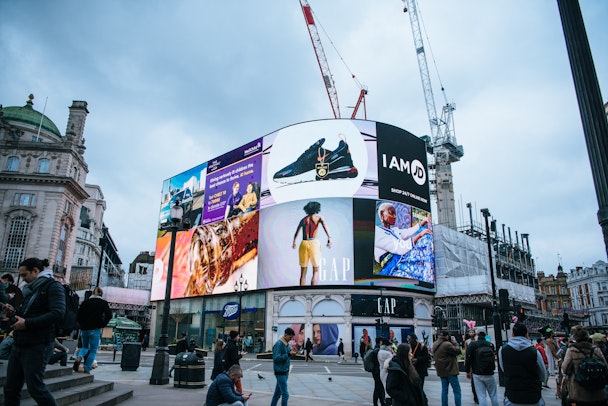How programmatic digital OOH advertising helps retailers in tricky times
For The Drum’s out-of-home advertising Deep Dive, Hannah Thompson of digital agency Tug looks at how programmatic integrations are changing the game.

Will programmatic digital out-of-home change the game? / Tânia Mousinho via Unsplash
With the threat of recession growing and consumers hit hard by the cost-of-living crisis, retail marketers must make every penny of ad spend as effective as possible.
In this year’s crucial seasonal retail period, shoppers will be looking to save money; nearly half are expecting bigger discounts. To deliver a pricing strategy that grabs consumers’ attention and drives sales, brands will need their campaigns to be highly targeted and agile. Whatever the channel, data will be a vital fuel for campaign success.
The out-of-home channel has traditionally been seen as powerful for brand awareness campaigns but lacking the flexibility, targeting and measurement that marketers have become accustomed to online. But using programmatic in digital out-of-home (DOOH) now provides marketers with exactly that. While consumers are being wowed by shiny new formats such as 3D billboards, marketers can make data-driven decisions behind the scenes.
Staying flexible
Like online, data informs every part of the programmatic DOOH purchasing process. This comes from several sources, including privacy-secure mobile IDs, geotemporal location data, environmental conditions, and a brand’s first-party data. Using this wealth of insight, marketers can make their programmatic DOOH activations adaptable and flexible, responding to changes in consumer behavior and the economic environment.
Places such as transport hubs, for example, have traffic peaks and troughs. With marketers able to see fluctuations in footfall thanks to third-party data sources, programmatic DOOH allows messaging to be pulled or redistributed from underperforming areas rapidly, or to run only when a minimum audience threshold has been met. This assures retail marketers that their seasonal promotions aren’t running in an empty train station and that spend is optimized.
Programmatic DOOH also allows creative to be adjusted in real-time to deliver dynamic pricing and promotions. If an advertising campaign includes creative for several products on offer across a supermarket chain and one location sells out of mince pies, DOOH displays in the surrounding area can be updated to promote other products.
Advertisement
Finding your audience: contextual targeting
A key strength of digital programmatic is its ability to target consumers based on interests and online behavior. Programmatic DOOH’s granular audience targeting capabilities move it further in line with its online counterpart. However, OOH remains a unique channel. While other channels are centered on one-to-one targeting, out of home's unique strength is its one-to-many capabilities. So how can marketers combine this with targeting?
One way is through contextual targeting. With the range of geolocation data available via programmatic DOOH, activations can be centered around locations that are contextually relevant to messaging. Gym-goers can be delivered an ad for deals on Apple watches where they work out, or sports apparel companies can run promotions on tube lines connecting to the stadium on game day. Contextual ad placement can produce significant increases in both brand recall and awareness in a privacy-secure fashion. With the depreciation of third-party cookies, this will become even more valuable.
Meanwhile, anonymized mobile IDs build clearer insights into consumer journeys and allow messaging to be activated when a minimum threshold of a targeted audience is in an area. A fashion retailer could activate an ad in a location when a minimum number of people who have previously visited one of their stores are present, ensuring that messaging is garnering high-quality impressions.
Advertisement
Measuring success
The proof is in the pudding with programmatic DOOH. The wealth of data harnessed via programmatic DOOH, as well as advanced machine learning, means that brand lift, impressions and intent can be measured to better understand business outcomes. Marketers can analyze in real time which time of day is most effective to run campaigns. And consumer journeys can be more effectively visualized, allowing marketers to trace how audiences interact with various touchpoints. These insights are vital to understanding the impact of price changes or promotions on the behavior of consumers. And all of this allows DOOH reporting to be executed like its online counterpart.
For retailers looking to deliver an effective pricing and promotions strategy that captures consumer spend this festive season, programmatic DOOH will serve them well. Combining the large-scale, eye-catching displays the channel is traditionally known for with the ability to change messaging and creative in-flight allows for a truly agile strategy.
The current global situation is only the latest in a series of events (pandemic, war in Ukraine supply chain woes) that have impacted retailers and consumers in recent years. Programmatic DOOH should not just be for Christmas; smart retailers will continue to leverage its benefits as we navigate the uncertain times ahead.
Content by The Drum Network member:

Tug Agency
Tug is a performance driven, global digital marketing agency, optimised to grow ambitious brands, through the smart combination of data, media, content and technology.
Our...

